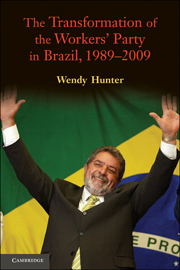Book contents
- Frontmatter
- Contents
- Tables, Charts, and Figure in Text
- Tables and Chart in the Appendix
- Acronyms
- Acknowledgments
- 1 Introduction: Understanding the Normalization of the Workers' Party
- 2 Strategic Change or Organizational Persistence? Evolution of the Workers' Party
- 3 Opposition Politics: The PT in the Chamber of Deputies
- 4 The PT in Municipal Government: The Pragmatic Face of the Party
- 5 Striving for the Presidency: From Opposition to Government
- 6 New Challenges and Opportunities: The PT in Government, 2003–2009
- 7 Analytical Implications and Comparative Perspectives
- Appendix
- References
- Interviews
- Index
2 - Strategic Change or Organizational Persistence? Evolution of the Workers' Party
Published online by Cambridge University Press: 05 June 2012
- Frontmatter
- Contents
- Tables, Charts, and Figure in Text
- Tables and Chart in the Appendix
- Acronyms
- Acknowledgments
- 1 Introduction: Understanding the Normalization of the Workers' Party
- 2 Strategic Change or Organizational Persistence? Evolution of the Workers' Party
- 3 Opposition Politics: The PT in the Chamber of Deputies
- 4 The PT in Municipal Government: The Pragmatic Face of the Party
- 5 Striving for the Presidency: From Opposition to Government
- 6 New Challenges and Opportunities: The PT in Government, 2003–2009
- 7 Analytical Implications and Comparative Perspectives
- Appendix
- References
- Interviews
- Index
Summary
Events of the late twentieth century put leftist parties in a bind all over Latin America. This was true for Brazil as well. While the international socialist referent lost ground symbolically, economic developments in the very countries where left parties had gained traction forced them into a difficult position. Trade opening, privatization, and the reform and restructuring of the state – backed in considerable measure by key domestic elites, international financial institutions, and public opinion itself – required such parties to adapt in order to survive politically. Successful adaptation generally entails changes in strategy and organization that improve a party's ability to gain and keep electoral office amidst changing environmental challenges. The specific changes required depend on the given context, but in general they involve orienting the party away from the preferences of militants and more toward those of large groups of voters. These changes must find support within the party and the electorate.
To help us understand and assess adaptations within the PT, this chapter presents two broad analytical frameworks – rational choice and historical institutionalism – that offer different insights and perspectives on the issue of change, and it examines several studies on political parties that draw on these frameworks in key ways. Against this backdrop, the chapter examines and analyzes the distinctiveness of the PT as a mass left party prior to the mid-1990s, and it explains how and why it became a more electoral-professional and catchall party in the decade thereafter.
- Type
- Chapter
- Information
- Publisher: Cambridge University PressPrint publication year: 2010

